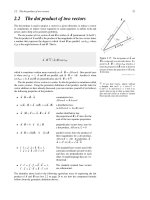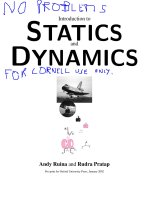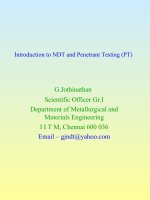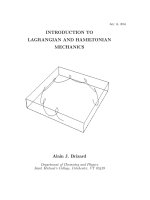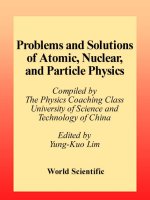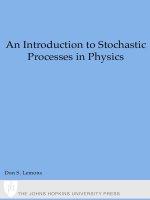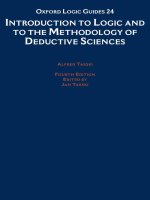- Trang chủ >>
- Khoa Học Tự Nhiên >>
- Vật lý
Introduction to nuclear and particle physics
Bạn đang xem bản rút gọn của tài liệu. Xem và tải ngay bản đầy đủ của tài liệu tại đây (10.25 MB, 613 trang )
Introduction to
Nuclear and Particle
Physics
Third Edition
V.K. MITTAL
Professor of Physics
Punjabi University, Patiala
R.C. VERMA
Professor of Physics
Punjabi University, Patiala
S.C. GUPTA
Former Professor and Head
Department of Physics
Punjabi University, Patiala
Delhi-110092
2013
.
INTRODUCTION TO NUCLEAR AND PARTICLE PHYSICS, Third Edition
V.K. Mittal, R.C. Verma and S.C. Gupta
© 2013 by PHI Learning Private Limited, Delhi. All rights reserved. No part of this
book may be reproduced in any form, by mimeograph or any other means,
without permission in writing from the publisher.
ISBN-978-81-203-4738-0
The export rights of this book are vested solely with the publisher.
Third Printing (Third Edition) … … … April, 2013
Published by Asoke K. Ghosh, PHI Learning Private Limited, Rimjhim House, 111,
Patparganj Industrial Estate, Delhi-110092 and Printed by Raj Press, New Delhi110012.
.
Contents
Preface…xiii
Preface to the First Edition…xv
1. The Nucleus…17–45
1.1 Introduction……1
1.2 Historical Developments……1
1.3 Constituents of the Nucleus……3
1.3.1 Proton–Electron Hypothesis……3
1.3.2 Proton–Neutron Hypothesis……5
1.3.3 Terms Associated with the Nucleus……7
1.4 Quantitative Facts about Nucleus……8
1.4.1 Size……8
1.4.2 Mass……9
1.4.3 Density……10
1.4.4 Energy……11
1.4.5 Charge……12
1.5 Binding Energy……12
1.5.1 Mass Defect……12
1.5.2 Packing Fraction……13
1.5.3 Fusion and Fission……14
1.5.4 Binding Energy per Nucleon……14
1.6 Nuclear Angular Momentum……16
1.7 Nuclear Moments……18
1.7.1 Magnetic Dipole Moment……18
1.7.2 Electric Quadrupole Moment……20
1.8 Wave Mechanical Properties……22
1.8.1 Parity……23
1.8.2 Statistics……23
1.9 Nature of Nuclear Forces……24
1.10 Yukawa Theory of Nuclear Forces……26
1.11 Mass Spectrometry……27
1.11.1 Bainbridge Spectrograph……28
1.11.2 Bainbridge and Jordan Mass Spectrograph……30
1.12 Determination of Charge by Moseley Law……31
Numerical Problems……32
Review Questions……43
2. Nuclear Models…46–78
2.1 Introduction……46
2.2 Liquid Drop Model……47
2.2.1 Semiempirical Mass Formula……47
2.2.2 Mass of Most Stable Isobar……51
2.2.3 Achievements of Liquid Drop Model……52
2.2.4 Failures of Liquid Drop Model……52
2.3 Shell Model……52
2.3.1 The Square Well Potential……56
2.3.2 The Harmonic Oscillator Potential……59
2.3.3 Spin-Orbit Coupling……61
2.3.4 Predictions of the Shell Model……62
2.3.5 Achievements of the Shell Model……64
2.3.6 Failures of Shell Model……65
*2.4 Fermi Gas Model……65
2.5 Collective Model……67
Numerical Problems……67
Review Questions……76
3. Radioactivity…79–153
3.1 Introduction……79
3.2 Laws of Disintegration……81
3.2.1 Activity and its Units……82
3.2.2 Half-life……83
3.2.3 Average (Mean) Life……84
3.3 Radioactive Series……85
3.4 Law of Successive Disintegration……87
3.4.1 Radioactive Equilibrium……90
3.5 Alpha Emission……94
3.5.1 Properties of Alpha Particles……96
3.5.2 Alpha Spectrum……96
3.5.3 Range of Alpha-Particles……98
3.5.4 Geiger–Nuttal Law……98
3.5.5 Gamow Theory of Alpha Decay……99
3.6 Beta Decay……107
3.6.1 Conditions for Spontaneous Emission of
Particles……107
–-
3.6.2 Conditions for Spontaneous Emission of
Particles……108
3.6.3 Beta-Particle Spectrum……109
3.6.4 Electron Capture……112
3.6.5 Neutrino ( ) and Antineutrino ( )……112
3.6.6 Detection of Antineutrino ( )……112
3.6.7 Detection of Neutrino ( )……113
3.7 Gamma Decay……114
3.7.1 Gamma Decay……114
3.7.2 Internal Conversion……115
3.7.3 Internal Pair Conversion……116
3.8 Artificial or Induced Radioactivity……118
* 3.9 Applications of Radioactivity……119
3.9.1 Medicine……120
3.9.2 Food and Agriculture……120
3.9.3 Insect Control……120
3.9.4 Reactors……121
3.9.5 Research Reactors……122
3.9.6 Geology and Element Identification……123
3.9.7 Radioactive Dating……123
3.9.8 Radioactive Tracers……125
3.9.9 Neutron Activation Analysis (NAA)……126
3.9.10 In Space Flights……126
+-
3.9.11 In Sea……127
Numerical Problems……127
Review Questions……150
4. Nuclear Reactions…154–202
4.1 Introduction……154
4.2 Types of Nuclear Reactions……156
4.2.1 Reactions Based on the Reaction Mechanism……
156
4.2.2 Reactions Based on the Mass of Projectile……158
4.3 Nuclear Reaction Cross-Section……163
4.3.1 Measurement of Cross-Section……163
4.3.2 Units of Cross-Section……164
4.3.3 Different Types of Cross-Sections……165
4.4 Conservation Laws in Nuclear Reactions……165
4.4.1 Conservation of Mass-Energy……166
4.4.2 Conservation of Linear Momentum……166
4.4.3 Conservation of Charge/Atomic Number……166
4.4.4 Conservation of Nucleons/Mass Number……166
4.4.5 Conservation of Angular Momentum……167
4.4.6 Conservation of Spin……167
4.4.7 Conservation of Statistics……167
4.4.8 Conservation of Parity……167
4.4.9 Conservation of Lepton Number……167
4.5 Kinematics of Nuclear Reactions……168
4.5.1 Exoergic or Exothermic Reactions……170
4.5.2 Endoergic or Endothermic Reactions……171
4.5.3 Threshold Energy……171
4.6 Compound Nucleus……172
* 4.7 Nuclear Fission……173
4.7.1 Neutron-Induced Fission……173
4.7.2 Energy Released in Fission……175
* 4.8 Nuclear Fusion……176
4.8.1 Energy Released in Fusion……177
4.8.2 Hydrogen Burning and Solar Energy……178
4.8.3 Helium Burning in Stars……179
Numerical Problems……180
Review Questions……201
5. Interaction of Radiations with Matter…203–
241
5.1 Introduction……203
5.2 Energy Loss by Heavy Charged Particles……203
5.3 Interaction of Electrons with Matter……208
5.4 Range of Charged Particles……210
5.5 Interaction of Gamma Rays with Matter……211
5.5.1 Radiation Length……213
5.5.2 Half-thickness……213
5.5.3 Experimental Determination of Attenuation
Coefficient……213
5.6 Photoelectric Effect……215
5.6.1 Experimental Verification of Photoelectric
Effect……217
5.7 Compton Effect……219
5.7.1 Experimental Verification of Compton Effect……
222
5.8 Pair Production……224
5.8.1 Positron Annihilation……225
Numerical Problems……226
Review Questions……239
6. Particle Accelerators…242–282
6.1 Introduction……242
6.2 Cockcroft and Walton Accelerator……243
6.2.1 Principle……243
6.2.2 Construction……243
6.2.3 Working……244
6.2.4 Advantages……244
6.2.5 Limitations……244
6.3 Van de Graaff Accelerator……245
6.3.1 Principle……245
6.3.2 Construction……245
6.3.3 Working……246
6.3.4 Advantages……246
6.3.5 Limitations……247
6.4 Tandem Accelerator……247
6.4.1 Principle……247
6.4.2 Construction and Working……247
6.4.3 Advantages……248
6.4.4 Limitations……248
6.5
Linear
Accelerator
(LINAC)
or
Drift
Tube
Accelerator……249
6.5.1 Principle……249
6.5.2 Construction……249
6.5.3 Working……250
6.5.4 Advantages……251
6.5.5 Limitations……252
6.6 Wave-Guide Accelerators……252
6.7 Magnetic Resonance Accelerators or Cyclotrons……
252
6.7.1 Principle……253
6.7.2 Construction……253
6.7.3 Working……254
6.7.4 Theory……254
6.7.5 Advantages……256
6.7.6 Limitations……256
6.8 Betatron……257
6.8.1 Principle……257
6.8.2 Construction……257
6.8.3 Working……258
6.8.4 Average Energy per Orbit……259
6.8.5 Calculation of Final Energy of Electrons……259
* 6.9 Synchrocyclotrons or Frequency Modulated
Cyclotrons……261
6.9.1 Principle……261
6.9.2 Construction……261
6.9.3 Theory……262
6.9.4 Advantages……263
6.9.5 Limitation……263
* 6.10 Azimuthally Varying Field (A.V.F.) or Sector Focusing
Cyclotrons……263
6.10.1 Principle……263
6.10.2 Construction……264
6.11 Synchrotrons……265
6.11.1 Proton Synchrotron……265
Numerical Problems……268
Review Questions……282
7. Radiation Detectors…283–325
7.1 Introduction……283
7.2 Gas-Filled Detectors……284
7.2.1 Principle……285
7.2.2 Construction and Working……285
7.2.3 Concept of Average Energy Required for Creating
Electron–Ion
Pair (W-value)……285
7.3 Ionization Chamber……288
7.3.1 Principle……288
7.3.2 Construction……288
7.3.3 Working……289
7.3.4 Main Uses……289
7.3.5 Main Drawback……289
7.4 Proportional Counters……289
7.4.1 Principle……290
7.4.2 Construction……290
7.4.3 Working……290
7.4.4 Uses……292
7.4.5 Main Disadvantage……292
7.5 Geiger–Müller (GM) Counters……292
7.5.1 Principle……293
7.5.2 Construction……293
7.5.3 Working……293
7.5.4 Main Uses……296
7.5.5 Main Drawback……296
7.6 Scintillation Detectors……297
7.6.1 Scintillation Detector/Crystal……297
7.6.2 Photomultiplier Tubes……299
7.6.3 Electronic Circuitry……300
7.6.4 Uses of Scintillation Detectors……301
7.6.5 Limitations of Scintillation Detectors……301
7.7 Semiconductor Radiation Detectors……301
7.7.1 Diffused Junction Detector……303
7.7.2 Silicon Surface Barrier Detectors……304
7.7.3 Ion Implantation Detectors……304
7.7.4 Silicon Lithium Si(Li) Detectors……304
7.7.5 Germanium Lithium Ge(Li) Detectors……305
7.7.6 High Purity Germanium Detectors……306
7.8 Cloud Chamber……307
7.8.1 Principle……307
7.8.2 Construction……307
7.8.3 Working……308
7.8.4 Advantages……308
7.8.5 Limitations……308
7.9 Bubble Chamber……308
7.9.1 Principle……308
7.9.2 Construction……309
7.9.3 Working……309
7.9.4 Advantages……309
7.9.5 Limitations……310
7.10 Spark Chamber……310
7.10.1 Principle……310
7.10.2 Construction……310
7.10.3 Working……310
7.10.4 Advantages……310
7.10.5 Limitation……311
7.11 Nuclear Emulsions……311
7.11.1 Advantages……312
7.11.2 Limitations……312
7.12 Cerenkov Counters……312
7.12.1 Advantages……313
7.12.2 Limitations……314
Numerical Problems……314
Review Questions……324
8. Particle Physics…326–374
8.1 Introduction……326
8.2 Production of Elementary Particles……327
8.2.1 Cosmic Rays……327
8.2.2 Particle Accelerators……327
8.2.3 Nuclear Reactors……328
8.3 Types of Interactions……328
8.3.1 Gravitational Interactions……328
8.3.2 Electromagnetic Interactions……329
8.3.3 Strong Interactions……329
8.3.4 Weak Interactions……330
8.4 Classification of Elementary Particles……330
8.4.1 Quanta of Forces……331
8.4.2 Matter Particles……332
8.4.3 Antiparticles……332
8.4.4 Observation and Production of Antimatter……333
8.5 Mass Spectra and Decays of Elementary Particles……
333
8.5.1 Leptons……334
8.5.2 Hadrons……337
8.5.3 Mesons……338
8.5.4 Baryons……340
8.6 Quantum Numbers……343
8.6.1 Spin (S)……343
8.6.2 Charge (Q)……344
8.6.3 Parity (P)……344
8.6.4 Lepton Number (L)……344
8.6.5 Baryon Number (B)……345
8.6.6 Isospin (I)……345
8.6.7 Strangeness (S)……346
8.6.8 Gell–Mann–Nishijima Scheme……346
8.6.9 Hypercharge (Y)……348
8.7 Conservation Laws……348
8.7.1 Conservation of Charge……349
8.7.2 Conservation of Lepton Number……349
8.7.3 Conservation of Baryon Number……350
8.7.4 Conservation of Isospin (I)……350
8.7.5 Conservation of Component of Isospin (I3)……351
8.7.6 Conservation of Hypercharge……351
8.7.7 Conservation of Parity (P)……351
8.7.8 Conservation of Charge Conjugation Parity (C)……
352
8.7.9 Time Reversal (T) Symmetry……352
8.7.10 CPT Theorem……352
8.7.11 Permutation Symmetry and Spin Statistics
Theorem……352
8.8 Weak Decays of Strange Particles……353
* 8.9 Particle Symmetries……353
8.9.1 SU(2) Symmetry……354
8.9.2 SU(3) Symmetry……355
8.9.3 Higher Symmetries……357
8.10 Quarks……357
8.11 Qualitative Description of Quark Model……358
8.11.1 Observation of Quarks……363
8.11.2 Colour: A New Degree of Freedom……364
* 8.12 Recent Developments……365
8.12.1 Quantum Field Theory of Interactions……365
8.12.2 Unification of Fundamental Forces……366
Numerical Problems……367
Review Questions……372
9. Cosmic Rays…375–382
9.1
9.2
9.3
9.4
9.5
Introduction……375
Discovery of Cosmic Rays……375
The Latitude Effect……376
East–West Asymmetry Effect……377
The Altitude Effect……377
9.6 Primary and Secondary Cosmic Rays……378
9.6.1 Primary Cosmic Rays……378
9.6.2 Secondary Cosmic Rays……378
9.7 Cosmic-Ray Showers……379
9.8 Origin of Cosmic Radiations……380
9.8.1 Solar Cosmic Radiations 380
9.8.2 Galactic Cosmic Radiations……381
9.8.3 Extragalactic Cosmic Radiations……381
Review Questions……381
Appendix A…Useful Constants…383–385
Appendix B…The Periodic Table…386
Appendix C…Table of Elements…387–389
Appendix D…Myths and Realities…390–391
Index…393–398
Note: Some sections of this book marked with asterisk (*)
may be skipped in the first reading.
.
Preface
We feel encouraged by the wide spread acceptability this
book has received in its first and second editions. This
prompted us to bring out the next edition. In preparing this
edition, we have been fortunate in receiving constructive
suggestions and comments from several teachers and other
readers, which we have now incorporated. In particular,
some sections of Chapters 3 to 6 have been revised. We
highly appreciate the time and efforts put by the readers in
reading the book critically which has helped us in making it
more useful. We take this opportunity to express our sincere
thanks to all of them, particularly Dr. S.K. Arora, Professor of
Physics, D.N. College, Hissar. We also express our thanks to
the publisher for bringing out this edition in time.
V.K. Mittal
R.C. Verma
S.C. Gupta
.
Preface to the First Edition
This comprehensive textbook is the outcome of wide
teaching and research experience of the authors. It is
designed for B.Sc. (Physics) students of Indian universities.
It can also be used as an introductory review material at
Masters level. This well-organized and concise text
discusses in detail the principles and applications of nuclear
and particle physics explaining the latest developments. The
text assumes knowledge of the fundamental concepts of
quantum mechanics, electricity, magnetism and modern
physics.
The book has been divided into nine chapters. Chapter 1
deals with the basic concepts and definitions. Chapter 2
discusses nuclear models including liquid drop model, shell
model, and fermi gas model.
Chapter 3 covers the phenomenon of radioactivity, laws of
disintegration and applications of radioactivity. Chapter 4
presents nuclear reactions. It covers various types of
reactions including reactions occurring in sun and stars.
Chapter 5 emphasizes the interaction of radiations with
matter and covers photoelectric effects, Compton effect and
pair production. In Chapter 6, particle accelerators are
discussed.
In Chapter 7, different types of radiation detectors are
explained. Chapter 8 introduces the elementary particles
and their interactions in detail. This chapter is capped with
the latest advances. Since it is a very active and frontier
area of research, it will help the reader to get a bird’s eye
view of the latest developments. This chapter also provides
new terms and concepts. The final chapter deals with
cosmic rays mainly due to historical reasons.
The discussion on the topics is simple and lucid avoiding
complicated mathematical
derivations. Actual data, graphs and figures are displayed to
elaborate clarification of the topics. A variety of solved and
unsolved numerical problems are included topic-wise to
enhance the student’s understanding of the subject. The
book also contains short and long answer type questions,
which are taken from various examinations of Indian
universities. Some sections of
this book in the contents marked with asterisk (*) may be
skipped in the first reading.
Finally, we owe a deep sense of gratitude to our families
for showing patience, which enabled us to complete this
work. Also during our teaching tenures, several concepts
were clarified by interactions with the students and
colleagues. We owe a word of gratitude to all our students
and colleagues who inspired us to complete the book.
V.K. Mittal
R.C. Verma
S.C. Gupta
Chapter
1
The Nucleus
1.1 INTRODUCTION
In this chapter, we present the concept of the nucleus,
nuclear constituents and nuclear properties, such as mass,
size, angular momentum, etc. To understand the concept of
nucleus, it is worthwhile to review the development of
various atomic models.
1.2 HISTORICAL DEVELOPMENTS
The beginning of the nuclear physics may be traced back to
the studies on atomic structure started with discovery of
radioactivity in 1896 by Henry Becquerel. Further, three
different modes of radioactivity were observed emitting aparticles, b-particles and g-rays. It is well known that
a-particles are helium nuclei, b-particles are either electrons
or positrons and g-rays are high-energy electromagnetic
radiations. Scattering of a-particles with matter revealed the
existence of nucleus inside the atom. In the following
paragraphs, various models are presented for establishing
the structure of atom and nucleus.
Dalton’s Atomic Hypothesis
The human beings have always been inquisitive to know the
basic nature of the matter present in the surroundings.
Breaking a piece of matter into smaller and smaller parts,
search was made for its constituents, which are capable of
independent existence. The atomic picture of matter is
generally credited to Greeks. Around 400 B.C., the Greek
philosopher Democritus postulated that all matter is made up
of minute particles, which could not be broken up. Around the
same times, perhaps earlier Kanada (an Indian philosopher)
proposed the concept of parmanu, which in the similar sense,
means ultimate constituents of matter. Continuing this
search, Dalton in 1803 proposed an atomic theory of matter,
which has the following postulates:
1. All elements consist of discrete particles, called atoms.
These atoms cannot be subdivided by any known
chemical process.
2. All atoms of the same element are identical in all
respects, especially in weight. Atoms of different
elements differ in weight.
3. A compound is formed by the union of atoms of different
elements in simple numerical proportions, for example, 1
atom of sodium combines with 1 atom of chlorine to
produce one molecule of sodium chloride. Similarly, 2
atoms of hydrogen and 1 atom of oxygen combine to
give a molecule of water.
Till the end of the nineteenth century, scientists did not
have any clue about the structure of atom. All that they knew
about the atom was that it is neutral. Works of Faraday,
Maxwell and
J.J. Thomson provided the first insight into the atomic
structure with the discovery of electron in 1897. It was also
realized that all atoms contain electrons, which carry
negative charge. Since atom is neutral, so positive charge
must be present in the atom. The question arises, what kind
of positive charge is present and how is positive charge
arranged in the atom?
Thomson Model of Atom
Discovery of electron in the famous cathode ray experiment
by J.J. Thomson provided a starting point for theories of
atomic structure. Since electrons are found to carry negative
charge, and atom on the whole is electrically neutral,
question arose about the magnitude and distribution of
positive charge inside the atom. One suggestion about the
arrangement of positive charge in the atom was made by J.J.
Thomson, who suggested that atoms are simply lumps of
matter with positive charge and electrons are embedded in
these lumps. This model is popularly known as Plum-Pudding
model, where plums are negative electrons which are placed
in the pudding of smeared positive charge. This model is also
called watermelon model, where seeds are negative
electrons. The pictorial representation is given in Figure 1.1.
This model was consistent with the observed overall
neutrality of the matter and explained the flow of current in
matter. As it turned out later, that the real picture of the
atom is quite different from Thomson’s model.
Figure 1.1 Plum-pudding model of the nucleus as given by J.J. Thomson. Plums
are represented by – sign and pudding is represented by + sign.
Rutherford Model of Atom
The failure of the Thomson model was finally established in
its inability to explain scattering of a-particles by atoms. The
scattering of a-particles can be described in terms of the
electrostatic Coulomb force between the a-particles and the
charges which make up atoms. In the case of Thomson
model, the average deflection of a-particles by a single atom
should be very small in contrast to the experimental results.
In 1911, Ernst Rutherford and his co-workers studied the way
the a-particles got scattered when they passed through thin
gold foil. They made the following observations:
1. Most of the a-particles went straight without getting
deflected by the presence of gold foil.
2. Some a-particles, whose numbers were comparatively
smaller, suffered small angle deviations.
3. Still smaller number of a-particles, about 1 in 8000, was
back-scattered, i.e. through angles lying between 90
and 180 .
Rutherford failed to explain these observations on the basis
of Thomson model. From these observations, it was
concluded that atom has large empty space as most of aparticles pass through the gold foil undeflected. So, he
proposed a new picture to explain the structure of atom. He
assumed that the positive charge of the atom was
concentrated in a minute centre, called nucleus, instead of
being distributed uniformly in whole of the atom. Thus,
Rutherford transformed the static model of Thomson into a
dynamic model, also known as the Planetary Model. He
concluded that atom contains a positively charged sphere
whose size was estimated to be 10–14 metres and he also
concluded that atomic mass is concentrated in this sphere.
This sphere was later on known as nucleus of the atom.
There are just enough electrons around the nucleus to make
atom electrically neutral. Rutherford developed a detailed
theory of the scattering of
a-particles by matter, which was tested in 1913 by Geiger
and Marden. They investigated dependence of the ascattering on various quantities like angle of scattering,
thickness of scattering material, velocity of a-particles,
nuclear charge, etc. The remarkable agreement between the
predictions of Rutherford’s theory and the experimental
results established the concept of the nuclear atom. In fact,
such experiments using faster a-particles showed deviations
from the Coulomb law of scattering, which provided the first
evidence of the existence of the nuclear force.
1.3 CONSTITUENTS OF THE NUCLEUS
So far, the atomic nucleus remains a vague concept. In the
Rutherford model, it has been described as very small, in fact
point-like, and is also supposed to contain practically all of
the mass of the atom. So, in later experiments more
quantitative information was sought about the size and
structure of the nucleus. In the following sections,
constitution of the nucleus is discussed.
As stated above, the nucleus of the atom has a very small
size (its volume is 10–15 times the volume of the atom i.e.
volume of the nucleus is of the order of 10–45 m3). This
compact size of the nucleus contains whole of the positive
charge and practically the whole mass of the atom. Following
are the two hypotheses to explain the compact structure of
the nucleus:
1. Proton–electron hypothesis.
2. Proton–neutron hypothesis.
1.3.1 Proton–Electron Hypothesis
In order to explain observed properties of the nucleus, firstly
it was proposed that the nucleus constitutes protons and
electrons. This model is known as proton–electron model. The
concept of the build-up of the nucleus in terms of the
elementary constituents was based on the fact that certain
atoms emit a- and b-rays, which are corpuscular in nature. As
proposed by Prout, atomic weights A of the elements are
close to integers. The fractional parts are contributed by the
isotopes of the elements. The mass of the proton is
approximately equal to the mass of the hydrogen atom. In
fact, the hydrogen nucleus was given the name proton, which
shows its importance as a fundamental constituent of nuclei
of all atoms.
To account for mass of the nucleus whose atomic weight is
close to integer A, called the mass number, it is necessary to
assume that nucleus contains A protons. But if this was the
case the charge of the nucleus will be equal to A, nearly the
same as atomic weight and not equal to atomic number Z. As
is well known, value of Z is half or less than half of the atomic
weight. To get over this difficulty, it was assumed that in
addition to protons the nuclei contain A – Z electrons. The
presence of electrons would not contribute to the mass of
nucleus but would make the charge Z as required. Thus, it
was possible to consider atom made up of a nucleus
containing A protons and A – Z electrons surrounded by Z
extra-nuclear electrons.
Success of the Proton–Electron Hypothesis
This hypothesis seems to be consistent with the emission of
a- and b-particles in radioactive elements. The presence of
electrons directly ensures the emission of b-particles, and
emission of a-particles is assumed by the combination of 4
protons and 2 electrons in the nucleus. These
a-particles may exist as such or may be formed at the instant
of emission.
Failure of Proton–Electron Hypothesis
Following are the arguments, which led to the failure of
proton–electron hypothesis.
1. Spin and statistics: The statistical nature of nuclei can
be built up from rotational spectra of diatomic
molecules. If the nucleus (A, Z) contains A protons and
(A – Z) electrons, the spin of odd–odd nucleus or odd–
even nucleus would not agree with experimental results.
Take the case of odd–odd nucleus 14N. An even number
of protons (i.e. 14) produces an integral spin, while an
odd number of electrons (i.e. 7) gives half-integral spin.
So the total spin of 14N in the proton–electron
hypothesis would be half-integral spin and thus 14N
would be a fermion system. But the experimental results
show that 14N is a boson, i.e. it carries integral spin,
which could not be explained in the proton–electron
hypothesis.
2. Binding energy: As discussed later in Chapter 8,
electron being a lepton cannot take part in strong
nuclear interactions. Strong interactions bind the
nucleons together in the nucleus. If electrons were
present in nucleus, the bound state is caused by
Coulomb interaction and the binding energy is of the
order of
where r is the radius of the nucleus and is given by 1.2
10–15 A1/3 m or 1.2
A1/3 fm (1 fm = 10–15 m).
Negative sign means that the system is bound. Thus,
Thus,
The de Broglie wavelength of the electrons having energy =
15 MeV would be
This value is much greater than the size of the nucleus.
Hence, electrons cannot exist inside the nucleus as
bound electrons.
3. Nuclear magnetic moment: Magnetic moment of an
electron is one Bohr magneton
while that of a
proton is one nuclear magneton
Thus,
mB 1850
mN, where mN/me
1850. If the nucleus
consisted of protons and electrons, the nuclear magnetic
moment should be of the order of mB while
experimentally nuclear magnetic moment is of the order
of mN. Thus, electrons do not exist inside the nucleus.
4. Beta decay: As discussed later, b-decay is a three-body
process and not a two-body process. The electrons
emitted in proton–electron hypothesis would have a line
spectrum, i.e. all electrons carry same energy, while in
actual b-decay, b-energy varies continuously. This means
that in b-decay, b-particles are accompanied by a third
particle. This contradicts proton–electron hypothesis.
1.3.2 Proton–Neutron Hypothesis
After the discovery of neutrons by Chadwick in 1932 through
research on transmutation of nuclei by a-particles,
Heisenberg had earlier proposed that nuclei might be
composed of protons and neutrons, collectively called
nucleons. The neutron carries mass slightly greater than that
of the proton, but is electrically neutral. Due to no charge,
neutron was hard to detect and several unsuccessful efforts
were made before it was finally observed in 1932. Thus,
